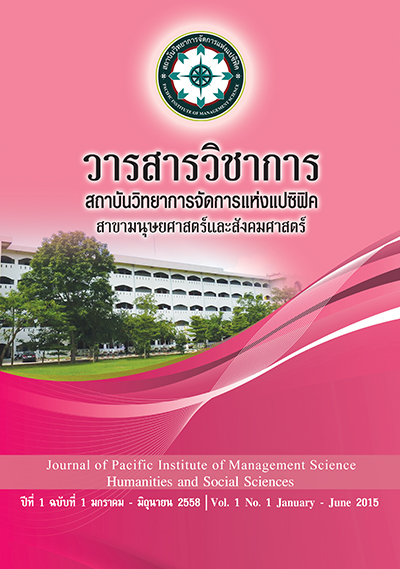Factors Relating to Stress at Work of Flight Attendants
Keywords:
Factors, Relating, Work of FlightAbstract
The purposes of this research are: 1) to study the personality, environmental perception level, quality of life at work and stress level of flight attendants during their duty; 2) to carry out comparative study on stress level at work of flight attendants during the discharge of their duty in accordance with such individual factors as gender, age, marital status, length of service, level of education and income; 3) to study the relationship of personality and stress level at work of flight attendants during their duty; 4) to study the relationship of environmental perception and stress level at work of flight attendants; 5) to study the relationship between quality of working life and stress level at work of flight attendants.
The sample of this research consisted of total 397 flight attendants from Nok Air, Bangkok Airways and Thai Airways International. The tool of this study was the questionnaire which is divided into five parts. Each part has a reliability level at 0.890, 0.960, 0.929 and 0.945 respectively. The questionnaires have been analyzed by statistical package program using mean, average, standard deviation t-test, F-test, (Least Significance Difference), Pearson’s product-moment correlation coefficient and statistical significant was specified at .05.
It was found from the study that;
1. Most of flight attendants had an emotionality stable personality while their environment perception and quality of working life were on the average. Stress at work was found at a low level.
2. Flight attendants with various individual factors with different gender, age, marital status, length of service, level of education and income were found not to be different in their stress level.
3. There was no relationship between personality, environmental perception, quality of working life and stress at work of flight attendants.
References
กิติกร มีทรัพย์. (2541). พฤติกรรมความเครียดและการตอบสนองต่อความเครียด. กรุงเทพฯ: กรมการแพทย์ กระทรวงสาธารณสุข.
เกษม ตันติผลาชีวะ. (2543). “ความเครียด” นิตยสารใกล้หมอ. 24(มีนาคม – เมษายน): 24-30
ฉันทนิช อัศวนนท์. (2543). การพัฒนาบุคลิกภาพ. กรุงเทพฯ : ศูนย์ส่งเสริมวิชาการ.
ชาญชัย อาจินสมาจาร. (2535). การฝึกอบรมและพัฒนาทรัพยากรบุคคล. กรุงเทพฯ: สายใจ.
________(2537). การบริหารการศึกษำ. กรุงเทพฯ : ศูนย์สื่อเสริม.
ชูทิตย์ ปานปรีชา. (2519). จิตวิทยาทั่วไป. นนทบุรี: มหาวิทยาลัยสุโขทัยธรรมาธิราช.
นงลกัษณ์ เทพสวสัด.ิ์ (2543). การจัดการกับความเครียดในที่ทำงาน: กรณีตัวอย่างการจัดการกับความเครียดในนักบิน.
รายงานการประชุมวิชาการสุขภาพจิต. กรุงเทพฯ : กระทรวงสาธารณสุข.
นริศรา วงค์เลย. (2551). ปัจจัยที่มีอิทธิพลต่อความเครียดในการทำงานของบุคลากรในเรือนจำกลางเชียงใหม่.
วิทยานิพนธ์รัฐประศาสนศาสตร์มหาบัณฑิต สาขารัฐประศาสนศาสตร์, มหาวิทยาลัยเชียงใหม่.
นันทวรรณ นาวี. (2536). คลายเครียด. พิมพ์ครั้งที่ 2. กรุงเทพฯ: โรงพิมพ์อักษรสมัย.
นิพนธ์ คันธเสวี. (2525). มนุษย์สัมพันธ์เพื่อการพัฒนาสังคม. กรุงเทพฯ: โรงเรียนสตรีเนติศึกษา.
นิศารัตน์ ศิลปเดช (2540). พัฒนาคุณภาพชีวิต. พิมพ์ครั้งที่ 2. กรุงเทพฯ: พิศิษฐ์การพิมพ์.
บรรยงค์ โตจินดา. (2546). การบริหารงานบุคคล. กรุงเทพฯ: รวมสาส์น.
บริษัทการบินไทย จำกัด (มหาชน). (2542). 39 ปี การบินไทย. (เอกสารเผยแพร่)
บุญแสง ชีระภากร. (2553). “การปรับปรุงคุณภาพชีวิตการทำงาน”. จุลสารพัฒนาข้าราชการ 25 (มกราคม-มีนาคม): 5-8.
ประณิตา ประสงค์จรรยา. (2542). ความเครียดในการปฏิบัติงานของผู้จัดการบริการบนเที่ยวบิน และหัวหน้ำพนักงาน
ต้อนรับบนเครื่องบิน บริษัทการบินไทย จำกัด (มหาชน). วิทยานิพนธ์ ศิลปศาสตรมหาบัณฑิต สาขารัฐศาสตร์,
มหาวิทยาลัยเกษตรศาสตร์.
ปรียชยา คล้ายทวน. (2551). สุขภาพดีวัยทำงาน. พิมพ์ครั้งที่ 2. กรุงเทพฯ: อมรินทร์สุขภาพ.
ปราโมช เชี่ยวชาญ. (2546). การควบคุมมลพิษอากาศ หน่วยที่ 5. สาระชุดวิชาการจัดการและควบคุมมลพิษทางอากาศ
จากอุตสาหกรรม. นนทบุรี: มหาวิทยาลัยสุโขทัยธรรมาธิราช.
ปรียาพร วงศ์อนุตรโรจน์. (2543). การบริหารงานวิชาการ. กรุงเทพฯ: ศูนย์สื่อเสริมกรุงเทพ.
พรพิมล วรวุฒิพุทธพงศ์. (2528). ความเครียดกับนักบริหาร. วารสารเทศาภิบาล 12 (ธันวาคม): 15-18.
พวงรตัน์ บญุญานรุกัษ์ (2536). 50 ปี ชีวิตและผลงานอาจารย์พวงรัตน์ บญุญานุรักษ์. กรงุเทพฯ: จุฬาลงกรณ์มหาวิทยาลัย.
อรุณ หงษ์ทอง. (2530). “ความเครียด” วารสารครูเชียงราย. 6 (มิถุนายน): 16 – 17.
อัสนียา สุวรรณศิริกุล. (2547). “คุณภาพชีวิตในการทำงาน.” วารสารคน. 25(4): 75-79.
อารี เพชรผุด. (2546). สภาพการทำงานและองค์ประกอบด้านบุคคล. กรุงเทพฯ:เนติกุลการพิมพ์.
อนุชาติ พวงสำลี. (2541). การพัฒนาเครื่องชี้วัดคุณภาพชีวิตและสังคมไทย. กรุงเทพฯ :
สำนักงานกองทุนสนับสนุนการวิจัย.
Antuano, M.J. (1997).“Stress and The Pilot”.Federal Air Surgeon’s Medical Bulletin. 20(June). New Jersey:
Prentice-Hall.
Arnold, H.J. and Feldman, D.C. (1986). Organizational Behavior. Singapore: McGraw-Hill, Inc.
Auerbach, S. M. and Gramling, S. E. (1997). “Stress and the Pilot”. Federal Air Surgeon’s
Medical Bulletin. 20 (June): 54-68 Gramling, S. E., & Auerbach, S.M.
Baron, R. A. (1995). Psychology. Massachusetts: Allyn & Bacon.
Barnes, B.L. (1992). Stress in Aviation Personnel. American Psychological Association. 37 (March): 1-6.
Beehr, T. A. and Newman, J. E. (1974). Job Stress Employee Health and Organizational
Effectiveness : A Facet Analysis, Model and Literature Review. Personnal Psychology. 31 (March ): 605-699.
Benton, D.A. (1998). Applied Human Relations: An Organization and Skill Development
Approach. 6th ed. Englewood cliffs NJ : Prentice Hall.
Brown, A. W. and Moberg, D. J.(1980). Organization Theory and Management: A Macro Approach. New York: John Willey and Sons, Inc.
Brown, L.M. (1964). The self-stress of dislocations and the shape of extended nodes. Philosophical Magazine. 10(105): 441-466
Cambridge University. (1995). International Dictionary of English.
Cambridge University Press.
Carlopio, J. (1996). Holistic organisational health: Curing the part by focusing on the whole.
In A. Gutschelhofer & J. Scheff(Eds.), Paradoxical Manageme. 10(15): 44-60
Downloads
Published
Issue
Section
License
บทความที่ได้รับการตีพิมพ์เป็นลิขสิทธิ์ของ สถาบันวิทยาการจัดการแห่งแปซิฟิค
ข้อความที่ปรากฏในบทความแต่ละเรื่องในวารสารวิชาการเล่มนี้เป็นความคิดเห็นส่วนตัวของผู้เขียนแต่ละท่านไม่เกี่ยวข้องกับสถาบันวิทยาการจัดการแห่งแปซิฟิค และคณาจารย์ท่านอื่นๆในสถาบันฯ แต่อย่างใด ความรับผิดชอบองค์ประกอบทั้งหมดของบทความแต่ละเรื่องเป็นของผู้เขียนแต่ละท่าน หากมีความผิดพลาดใดๆ ผู้เขียนแต่ละท่านจะรับผิดชอบบทความของตนเองแต่ผู้เดียว







